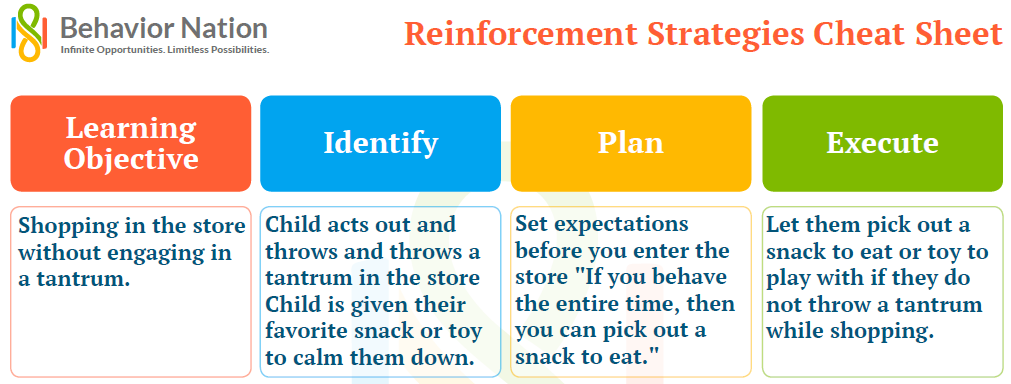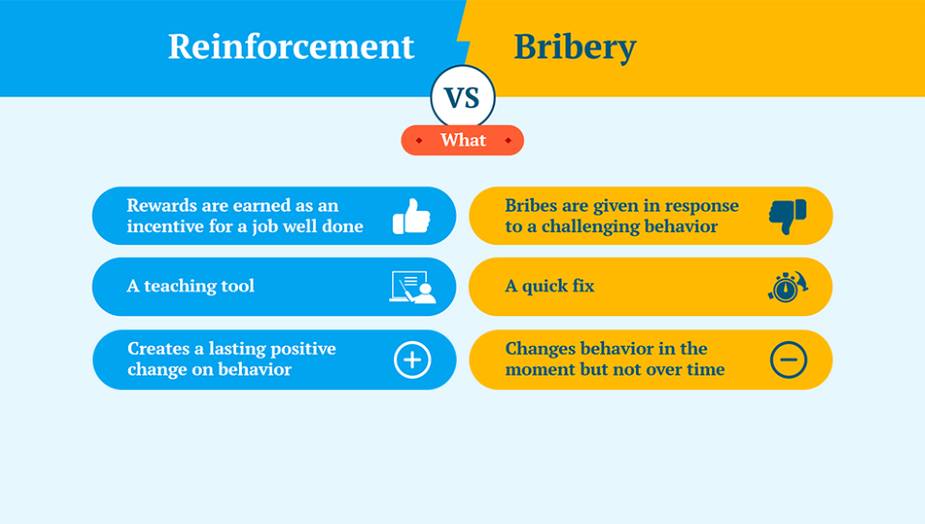Picture this: You’re with your child at the grocery store when they suddenly start to act out and throw a tantrum. So, you offer your child their favorite snack if they calm down.
Does that sound familiar?
This scenario is all too common for children diagnosed with developmental disabilities like autism spectrum disorder (ASD). While it seems innocent and practical at the moment, the act of bribing your child to behave can do more harm than good in the long run.
Bribery vs. Reinforcement
These two concepts are pretty similar, and both have positive and negative effects on your child.
Extrinsic rewards are a fantastic motivator for children with developmental disabilities, but how you provide those rewards can impact how they learn.
When you start to look into how these methods influence your child’s behavior moving forward, it becomes easier to see how reinforcement and bribery are two very different things.
What is Reinforcement?
Reinforcement is considered by many to be the cornerstone of Applied Behavior Analysis (ABA). Providing reinforcement is simple and often occurs naturally. Essentially, it’s an extrinsic reward that you offer up as an incentive for good behavior.
It exists under two conditions:
- The reward comes after the good behavior.
- The behavior is something you want to occur in the future.
The goal is to strengthen your child’s motivations and cement the skills you’re trying to teach. All the while, reinforcing good behaviors conditions your child by controlling the consequences of their actions.
The Benefits of Positive Reinforcement
There are many benefits to using reinforcement in your kid’s day-to-day life. The biggest is improved behavior over time.
Reinforcement is strengthening and encouraging a pattern of good behavior. Eventually, your child will understand the connection between the behavior and the reward. It’s all about the long game!
Using reinforcement strategically can make a world of difference in how kids learn. It’s a powerful teaching tool that you can easily incorporate into everything you do together.
The next significant benefit is that reinforcement provides ultimate instructional control. You are in charge, and you get to decide whether actions are worthy of a reward. You’re free to restrict or provide access to the reinforcer as you see fit, which puts the reins in your hands instead of the other way around!
What is Bribery?
Bribery also involves a reward. According to Meriam-Webster, it’s “something that serves to induce or influence.”
So, how does that differ from reinforcement? It all comes down to timing.
With reinforcement, you’re laying down the terms before the action occurs. With bribery, it comes after.
Bribes usually occur reactively and can also be out of frustration. It’s an attempt for parents to “put a lid” on the behavior, calm their child down, and put an end to the drama.
In ABA therapy, bribery is typically a no-go. While it does offer quick results, it involves no plan whatsoever. Bribes stem from emotional responses and only serve to stop a behavior once it already starts.
Why Bribery is an Ineffective Long-Term Solution
The biggest issue with bribery is how it subconsciously bolsters unwanted behaviors. With reinforcement, you’re rewarding positive actions.
However, bribery is like giving in and giving treats to your child to get them to stop whatever they’re doing! It doesn’t teach anything. Instead, it can exacerbate the problem moving forward.
Ultimately, bribery teaches kids that engaging in challenging behaviors gets them what they want. It has the opposite effect of what you’re after and doesn’t do a thing to decrease its occurrence in the future. They learn that if they do what they’re not supposed to, you’ll eventually cave in and offer a reward.
To make matters worse, it puts your child in control of the situation. You might be the one giving the reward but at the end of the day, your child decides when they get the reward.
Recognizing and Avoiding Bribery
Bribery does not teach any skills to a child with developmental disabilities like autism. It is easier to resort to bribery than most think.
To avoid making bribes in the future, you must learn to recognize those offers and understand how they differ from reinforcement.
The easiest way to identify bribes is to ask yourself these questions:
- Who is in charge?
- Did the offer come before or after the challenging behavior?
- Is the reward going to make a lasting change?
- Did you plan for this situation?
Let’s take a look at a couple of examples and how you can reinforce good behavior instead of bribing your child.
The Grocery Store Tantrum
Going back to the example from earlier, your child throws a tantrum in the middle of a store.

The Bribe
In an attempt to diffuse the situation, you offer your child a snack or toy if they calm down. Your frustrated response is a bribe because it came after they threw a tantrum and put your kid in control of the situation.
Reinforcement Alternative
Instead of bribing, you can go into the situation with reinforcement. Before you even enter the store, you could tell your child that they can pick out a snack to eat if they behave the entire time you’re shopping. Right off the bat, your kid has an incentive to be on their best behavior.
It wasn’t an offer made on emotions or reactions. Instead, you planned for the worst-case scenario!
The Picky Eater
In this example, you have a child who doesn’t like eating vegetables!

The Bribe
After sitting at the table for an hour and listening to complaints, you tell your young one that they can have dessert if they eat their vegetables. In ABA therapy, this is an ineffective bribe. Again, it’s out of frustration and handing the power to your child.
Reinforcement Alternative
You already know that your kid doesn’t enjoy vegetables. Before you set the food in front of them, offer up dessert if they finish their meal. The promise of a reward comes before the whining. Moving forward, your child knows that they can potentially get dessert if they eat vegetables in the future.
Types of Positive Reinforcers
Reinforcers are the key to success with Applied Behavior Analysis. You can use a wide range of tangible and intangible reinforcements to influence your child’s actions. They typically fall into one of five categories.
Sensory Input
Access to a sensory experience like a hug or pat on the back might seem simple, but it’s enough to make your child feel special and appreciated.
For example, you can give a hug anytime your kid cleans their room or behaves well. Doing so reinforces that positive behavior and encourages them to repeat it.
Tangibles
Tangible items include toys and accessories that your child likes.
Restricting and granting access to those items is a great way to encourage good behaviors.
Edibles
Edible reinforcements are delicious foods and drinks. Not all kids will respond to every food item out there. It’s essential to choose something your child enjoys for the most significant impact.
Social Praise
Social praise is the simplest reinforcer to give. When your child does well, give them a high five and a pat on the back! Shower them in verbal praise to make them feel good about what they did or didn’t do.
Activities
Activity reinforcement is granting your child access to a fun activity. For example, you could provide the opportunity to play video games, visit the park, or play outside. But of course, the reward is conditional and works to motivate.
Conclusion
As you can see, there’s a fine line between reinforcing good behaviors and bribing your child to stop unwanted behaviors.
Bribes are largely ineffective and do nothing to help your child’s development. Understanding the difference and learning to avoid bribery can mean the difference between positive results and continued frustration.
Now that you have some more insight into the effects of reinforcement and bribes, you can take steps to change how you interact with your child. Download our free cheat sheet to start planning new reinforcement strategies to replace bribery!





